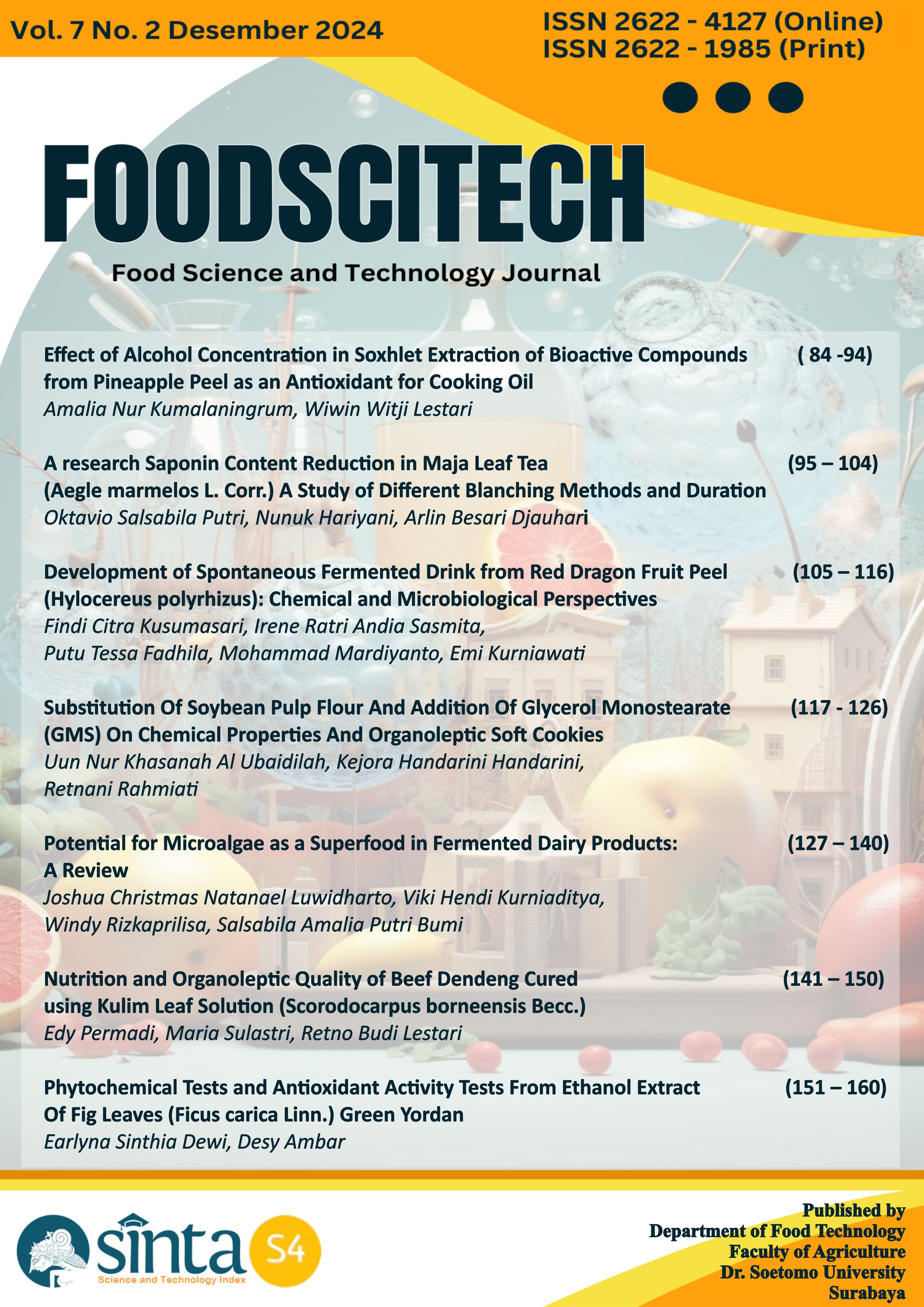Main Article Content
Abstract
Soy milk pulp is the residue produced after the extraction process of soy juice to produce soy milk. Soy milk pulp has a fairly high nutritional content, including fiber, protein, and several bioactive compounds. Research on soy milk pulp is relevant because of its potential in the development of highly nutritious food products and positive impact on the environment through waste management. The purpose of this study is to determine the effect of the interaction between the proportion of wheat flour and soybean pulp flour with GMS on the chemical and organoleptic properties of soft cookies so that good quality soft cookies are obtained and can be accepted by the public based on taste, color, and taste as well as high fiber and protein levels and good for health it can make people more interested in local food products with high nutritional value and increase the utilization of soy milk processing waste that is often unused around our environment. This research method uses a factorial Complete Randomized Design (RAL) consisting of two factors. The first factor is the proportion of wheat flour substitution with soy milk dregs flour into 3 levels, namely A1 (50%, 50%), A2 (40%, 60%), A3 (30%, 70%), and the second factor, namely the GMS concentration becomes 2 levels, namely B1(2%), B2(3%). The results showed that the best treatment based on all parameters obtained substitution of 60% soy milk pulp flour and the addition of 2% GMS was the best value with parameter criteria, namely water content = 12,0%, protein content = 8,94%, fiber content = 10.93%, fat content = 15,46%, color = 4 (like), taste = 4 (like), aroma = 4 (like), texture = 4 (like).
Keywords: soft cookies; soy milk pulp; GMS
Keywords
Article Details

This work is licensed under a Creative Commons Attribution-NonCommercial-ShareAlike 4.0 International License.

This work is licensed under a Creative Commons Attribution-ShareAlike 4.0 International License.
References
- Adhimah, N. N., Mulyati, A. H., & Widiastuti, D. 2017. Substitusi tepung terigu dengan tepung ampas kedelai pada produk cookies yang kaya akan serat pangan dan protein. Ekologia: Jurnal Ilmiah Ilmu Dasar dan Lingkungan Hidup, 17(1), 28-39.
- Ahmed, H., Satheesh, N., & Dibaba, K. 2018. Nutritional and anti-nutritional evaluation of cookies prepared from okara, red teff and wheat flours. International Food Research Journal, 25(5), 2042–2050.
- Aini, N., Sustriawan, B., Widyanti, A. P., & Mela, E. 2022. Formulasi cookies bebas gluten dari
- tepung jagung-almond yang disuplementasi tepung kacang hijau dan variasi pemanis. Agrointek: Jurnal Teknologi Industri Pertanian, 16(4), 588-598.
- Alvionita. 2017. Kenali Penyakit Seliaka, Intoleransi terhadap Gluten. Akg.Fkm.Ui.Ac.Id.https://akg.fkm.ui.ac.id/kenali-penyakitseliaka-intoleransi-terhadap-gluten/
- Anggita, I. A. 2023. Peningkatan nutrisi cookies bebas gluten dengan tepung daun kelor (moringa
- oleifera): uji proksimat dan organoleptik/Indah Anggita (Doctoral dissertation, Universitas Negeri Malang).
- Arum, D. P., & Kurnia, P. 2024. Pengaruh Subtitusi Tepung Ganyong Dan Tepung Sorgum
- Terhadap Kadar Air dan Kadar Abu pada Cookies Cokelat Bebas Gluten Berbahan Dasar Tepung Mocaf. Ranah Research: Journal of Multidisciplinary Research and Development, 6(6), 2739-2744.
- Basuki, E. K., Yulistyani, R., & Hidayat, R. 2013. Kajian substitusi tepung tapioka dan penambahan gliserol monostearat pada pembuatan roti tawar. Jurnal Teknologi Pangan, 5(2).
- Damayanti, S., Bintoro, V. P., & Setiani, B. E. 2020. Pengaruh penambahan tepung komposit terigu, bekatul dan kacang merah terhadap sifat fisik cookies. Journal of Nutrition College, 9(3), 180-186.
- Garnida, Y. 2020. Perbandingan tepung sorgum (sorgum bicolor l. moench) dengan tepung umbi ganyong (canna edulis) dan konsentrasi gliserol monostearate terhadap mutu cookies non gluten fortifikasi. Pasundan Food Technology Journal (PFTJ), 7(1), 17-25.
- Ijabadeniyi, O. A., Naidoo, K., Oyedeji, A. B., Oyeyinka, S. A., & Ogundele, O. M. 2023. Nutritional, functional, and pasting properties of maize meal-sprouted soybean flour enriched with carrot powder and sensory properties of the porridge. Measurement: Food, 9(May 2022), 100074.
- Latifah, R Nurismanto dan FA Putri. 2017. Penggunaan tepung beras htam dan gliserol monostearat pada pembuatan roti tawar. Jurnal Teknologi Pangan. 6(2): 1-11.
- Rahmaris, L. D., & Ratnaningsih, N. 2022. Inovasi Produk Soft Cookies Bebas Gluten
- Dari Tepung Mocaf Dan Tepung Porang Sebagai Alternatif Cookies Untuk Penderita Autis. Prosiding Pendidikan Teknik Boga Busana, 17(1).
- Wisnu, C., Yusep, I., Surachman, S., & Farida, N. 2019. Perbandingan tepung sorgum dengan umbi ganyong dan konsentrasi gliserol monostearate (gms) terhadap karakteristik cookies terfortifikasi zat gizi mikro. Jurnal Agroekoteknologi dan Agribisnis, 3(2), 1-12.
- Yustina I, FR Abadi. 2012. “Potensi tepung dari ampas industri pengolahan kedelai
- sebagai bahan pangan”. seminar nasional kedaulatan pangan dan energi,
- Madura, 12 Juni 2012, Universitas Trunojoyo. Bangkalan. Hal. 1-8
